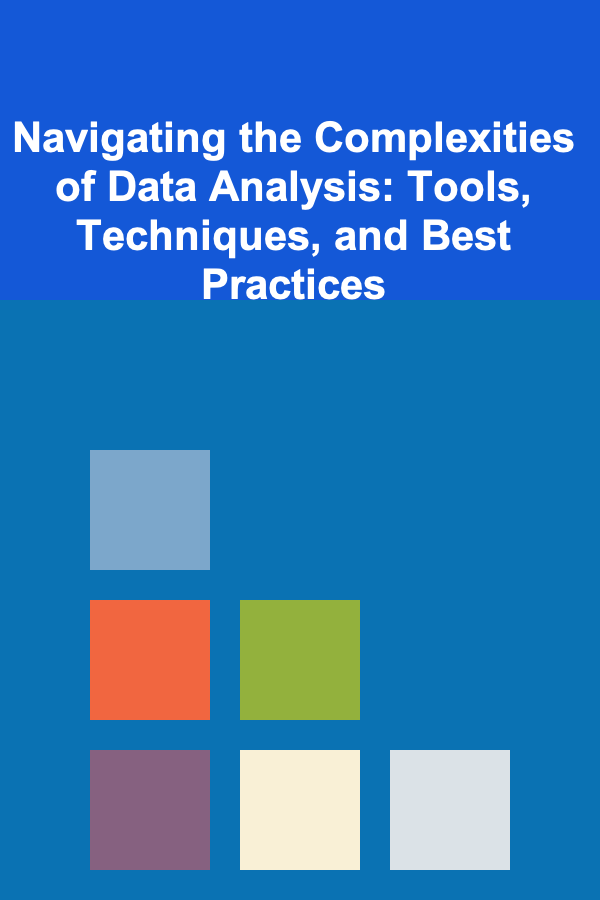
Navigating the Complexities of Data Analysis: Tools, Techniques, and Best Practices
ebook include PDF & Audio bundle (Micro Guide)
$12.99$7.99
Limited Time Offer! Order within the next:

In today's data-driven world, data analysis has become a critical component for businesses, governments, and researchers alike. Organizations are leveraging data to optimize processes, uncover new insights, and make informed decisions. However, the complexity of data, the variety of tools available, and the intricacies of the analysis process can make it challenging to navigate the field effectively. This guide aims to offer an actionable roadmap to help you understand the key tools, techniques, and best practices for navigating the complexities of data analysis.
Understanding the Fundamentals of Data Analysis
Data analysis is an iterative process that involves transforming raw data into meaningful insights. The core objective of data analysis is to extract actionable information from large datasets, enabling decision-makers to make better-informed choices. To achieve this, it's essential to understand both the theoretical and practical aspects of data analysis, from identifying business problems to interpreting results.
Defining the Problem
Every data analysis journey starts with defining the problem. Without a clear understanding of the problem you're solving, it's easy to get lost in the data. The first step in the process is to:
- Understand the Business Context: Ask yourself what questions you are trying to answer. Are you looking to predict sales, understand customer behavior, or optimize processes?
- Formulate Hypotheses: Once you understand the problem, formulate hypotheses that you can test through your data analysis.
- Define Key Metrics: Establish the key performance indicators (KPIs) that will help you measure success and evaluate the effectiveness of your analysis.
Data Collection and Sourcing
After defining the problem, the next step is to gather the right data. Data can come from a variety of sources:
- Internal Databases: These are your organization's own data sources, such as customer databases, transaction records, or system logs.
- Public Datasets: Many public sources provide free datasets that can be useful for analysis, such as government databases, academic repositories, or industry-specific reports.
- Third-Party Data Providers: Data can also be sourced from third-party companies that aggregate information, such as social media sentiment analysis, demographic data, or market trends.
The key challenge in data collection is ensuring that the data is relevant, accurate, and timely. Once collected, the data needs to be cleaned and prepared for analysis.
Data Preparation and Cleaning
Data preparation is often the most time-consuming phase of the data analysis process. Raw data is rarely perfect and can contain errors, missing values, duplicates, or irrelevant information. A good data analyst must have a strong skill set in cleaning and transforming data to make it suitable for analysis.
Common Data Issues
- Missing Data: Missing data can skew results and lead to inaccurate conclusions. It's essential to handle missing values through imputation or removal. Techniques like forward filling or mean imputation can be used, but each method must be carefully considered based on the dataset and the analysis.
- Duplicate Records: Duplicates can distort the results of your analysis. It's important to identify and remove duplicate entries to ensure the integrity of the dataset.
- Inconsistent Formatting: Data often comes in different formats, especially when collected from multiple sources. Standardizing formats (e.g., date formats, currency symbols) is essential for maintaining consistency across the dataset.
- Outliers: Outliers can affect statistical models and visualizations. Depending on the analysis, you may need to remove or adjust outliers to improve the accuracy of the results.
Tools for Data Cleaning
- Python Libraries (Pandas, NumPy): Python's Pandas library is one of the most widely used tools for data manipulation and cleaning. It allows analysts to easily clean, transform, and merge data.
- SQL: SQL is often used to manipulate and clean data directly within databases, such as filtering out rows with missing values or removing duplicates.
- Excel: For smaller datasets, Excel provides powerful built-in features like data validation, text-to-columns, and filtering, which can help clean and format data.
Data Exploration and Visualization
Once the data is clean, the next step is exploratory data analysis (EDA), where the goal is to get an understanding of the dataset's key characteristics. EDA involves using visual and statistical techniques to uncover patterns, trends, and relationships.
Visualization Techniques
Effective data visualization helps to communicate insights in a way that is easy to understand and interpret. Some popular visualizations include:
- Histograms: To show the distribution of a single variable.
- Box Plots: To identify outliers and the spread of the data.
- Scatter Plots: To visualize relationships between two continuous variables.
- Heatmaps: To visualize correlations or the frequency of data points across two variables.
Statistical Techniques
In addition to visualization, statistical techniques can be used to summarize the data and identify key relationships:
- Descriptive Statistics: This involves calculating metrics like mean, median, standard deviation, and percentiles to summarize the data.
- Correlation: Correlation analysis helps to understand relationships between different variables, and whether changes in one variable correspond to changes in another.
- Trend Analysis: Techniques like moving averages or exponential smoothing can help identify trends in time series data.
The key takeaway from EDA is that this step should help you identify patterns and inform the choice of further analysis techniques or models.
Statistical Analysis and Modeling
Statistical analysis allows analysts to test hypotheses and make predictions. Based on the business problem and the nature of the data, you may choose different modeling techniques. The goal is to build models that can help forecast outcomes or make decisions based on data.
Key Statistical Methods
- Linear Regression: Used for predicting continuous variables based on one or more independent variables.
- Logistic Regression: Used for binary classification problems, where the outcome is a categorical variable (e.g., customer churn prediction).
- Time Series Forecasting: Techniques like ARIMA or Prophet are commonly used to make predictions based on time series data.
- Classification Algorithms: Algorithms like decision trees, random forests, and support vector machines (SVM) are useful for classifying data into categories.
- Clustering Algorithms: Techniques such as K-means clustering or hierarchical clustering help group data points that are similar to each other.
Model Evaluation and Validation
Once a model is built, it needs to be evaluated. Common techniques include:
- Cross-Validation: This method involves splitting the data into training and testing subsets multiple times to ensure the model performs well across different data segments.
- Confusion Matrix: Used for classification models to visualize performance in terms of true positives, true negatives, false positives, and false negatives.
- Accuracy, Precision, Recall, and F1-Score: These metrics help evaluate the performance of classification models.
Handling Model Complexity
A common pitfall in data analysis is overfitting, where a model fits the training data too closely and fails to generalize to new data. To mitigate this, you can:
- Use simpler models when appropriate.
- Regularize the model (e.g., using Lasso or Ridge regression).
- Collect more data to improve the model's ability to generalize.
Best Practices in Data Analysis
While the tools and techniques mentioned above are essential, there are several best practices that data analysts should follow to ensure high-quality analysis.
1. Understand the Business Context
The most sophisticated analysis is useless if it doesn't address the right business problem. Always align your analysis with the business objectives and ensure your findings are actionable. Engage with stakeholders regularly to validate your approach.
2. Document Your Work
It's crucial to document your data analysis process. This includes:
- Keeping a record of the data cleaning steps you took.
- Documenting the assumptions made during modeling.
- Explaining the rationale behind choosing specific methods.
Clear documentation ensures transparency, allows others to replicate your work, and can help troubleshoot issues later on.
3. Communicate Findings Clearly
The results of data analysis need to be communicated effectively to non-technical stakeholders. Avoid jargon, and focus on delivering insights in a straightforward manner. Use visualizations to make your findings more intuitive, and always tie your results back to actionable recommendations.
4. Continuously Improve Models
Data analysis is an iterative process. After deploying a model, monitor its performance over time, and refine it as new data becomes available. Don't be afraid to revisit and adjust your approach based on feedback and new insights.
Conclusion
Navigating the complexities of data analysis requires a combination of strong technical skills, critical thinking, and a deep understanding of business objectives. By mastering the tools, techniques, and best practices outlined in this guide, you can effectively harness the power of data to drive informed decision-making. Whether you are just starting your career or are a seasoned data analyst, the key to success lies in continuously refining your approach, learning new techniques, and staying agile in a rapidly evolving field.
Reading More From Our Other Websites
- [Personal Care Tips 101] How to Select the Best Face Serum for Anti-Aging
- [Personal Care Tips 101] How to Use Hair Mousse for a Bouncy, Soft Look
- [Gardening 101] 10 Low‑Maintenance Plants That Thrive With Minimal Care
- [Home Party Planning 101] How to Host a Virtual Home Party That Feels Personal
- [Personal Financial Planning 101] How to Track Your Net Worth and Monitor Your Progress Towards Financial Independence
- [Home Soundproofing 101] How to Create a Peaceful Baby's Room with Simple Soundproofing Tips
- [Home Lighting 101] How to Create a Relaxing Bath Lighting Setup for Your Bathroom
- [Home Pet Care 101] Understanding the Signs of Pet Allergies
- [Small Business 101] How to Turn Your Blog Into a Lead‑Gen Engine for B2B Consulting Services
- [Home Family Activity 101] How to Create a Family Photo Album Project for Lasting Memories

How To Explore Decentralized Finance (DeFi) with Crypto
Read More
How To Discover New Treatments for Chronic Kidney Disease
Read More
Mastering the Pedal Wrench: A Comprehensive Guide to Pedal Installation and Removal
Read More
How to Brew Coffee with a Chemex for a Clean Cup
Read More
How to Budget for a Sporting Event Weekend: A Comprehensive Guide
Read More10 Tips for Accurate Capital Gains and Losses Tracking in Real Estate
Read MoreOther Products

How To Explore Decentralized Finance (DeFi) with Crypto
Read More
How To Discover New Treatments for Chronic Kidney Disease
Read More
Mastering the Pedal Wrench: A Comprehensive Guide to Pedal Installation and Removal
Read More
How to Brew Coffee with a Chemex for a Clean Cup
Read More